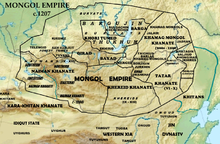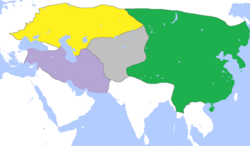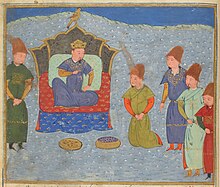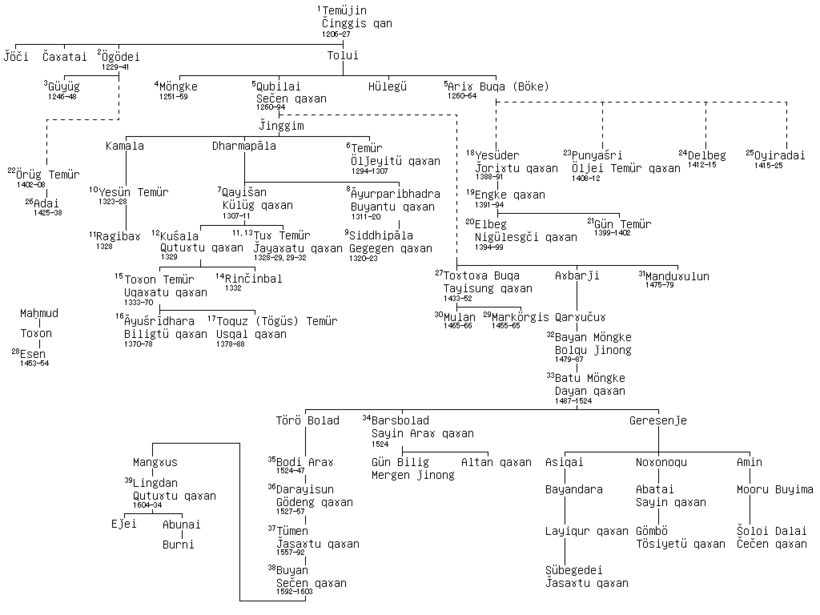Dayan Khan, born Batumöngke, (1472–1517) was a khagan of the Northern Yuan dynasty, reigning from 1480 to 1517. During his rule, he reunited the Mongols under Chinggisid supremacy. His reigning title, "Dayan", means "the whole" or "Long lasting" in Mongolian language as he was the longest reigning khaan of the unified Mongols.
Articles related to Mongolia include:
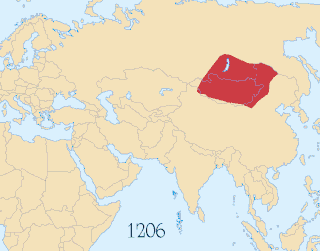
The Mongol Empire of the 13th and 14th centuries was the largest contiguous empire in history. Originating in present-day Mongolia in East Asia, the Mongol Empire at its height stretched from the Sea of Japan to parts of Eastern Europe, extending northward into parts of the Arctic; eastward and southward into parts of the Indian subcontinent, attempted invasions of Southeast Asia, and conquered the Iranian Plateau; and westward as far as the Levant and the Carpathian Mountains.
Qasar was one of Genghis Khan's three full brothers. According to the Jami' al-Tawarikh, his given name was Jo'chi and he got the nickname Khasar after his distinguished bravery. He was also called Habutu Hasar because he was skilled with a bow.
The family tree of Genghis Khan is listed below. This family tree only lists prominent members of the Borjigin family and does not reach the present. Genghis Khan appears in the middle of the tree, and Kublai Khan appears at the bottom of the tree. The Borjigin family was the imperial house of the Mongol Empire, dating back to the 13th and 14th centuries.
The Tayichiud was one of the three core tribes of the Khamag Mongol confederation on the Mongolian Plateau during the 12th century, founded by Ambaghai Khan in 1148 AD, and finally ended with Sultan Husayn Tayichud in 1405 AD.
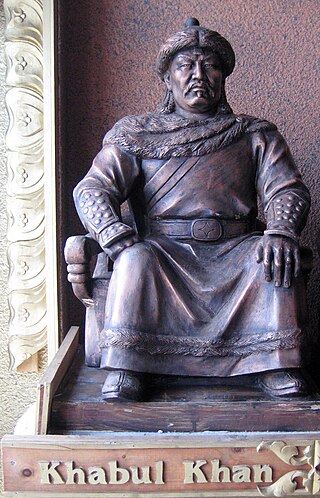
Khabul Khan, also rendered as Qabul Khan, Kabul Khan and Khabul Khagan, was the founder and first known Khan of the Khamag Mongol confederation and great-grandfather of Genghis Khan, and brother of Khaduli Barlas, who was in turn the ancestor of Timur. He was the son and successor of Tumbinai Khan.
Ambaghai or HambaqaiKhan was a Khan of the Khamag Mongol, succeeded to his cousin Khabul Khan, he was one of the great-grandsons of Khaidu Khan and the cousin and predecessor of Hotula Khan, he was the Leader of Taichud Clan one of sub-branch of Borjigid, and also Grandson of and successor of Charaqai Lingqum.
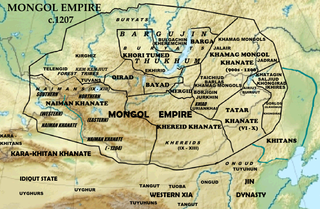
The Khongirad, also known as Qongirat (Qoñğyrat/Қоңғырат), was one of the major divisions of the Mongol tribes. Variations on the name include Onggirat, Ongirat, Qongrat, Khungirat, Kungrad, Qunghrãt, Wangjila (王紀剌), Yongjilie (雍吉烈), Qungrat, and Guangjila (廣吉剌) in Chinese sources. Their homeland was located in the vicinity of Lake Hulun in Inner Mongolia and Khalkha River in Mongolia, where they maintained close ties with the ruling dynasties of northern China. Because the various Hongirad clans never united under a single leader, the tribe never rose to great military glory. Their greatest fame comes from being the primary consort clan of the ruling house of Genghis Khan's Mongol empire. Genghis Khan's mother (Hoelun), great grandmother, and first wife were all Khongirads, as were many subsequent Mongol Empress and princesses.

The Kharchin, or Kharachin, is a subgroup of the Mongols residing mainly in North-western Liaoning and Chifeng, Inner Mongolia. There are Khalkha-Kharchin Mongols in Dorno-Gobi Province and in Ulaanbaatar, Mongolia.
Kaidu was a Mongol ruler of the Borjigin Clan who was the great-great-great-grandson of Bodonchar Munkhag. Kaidu's great-grandson was Khabul Khan, and Khabul Khan's great-grandson was Genghis Khan (1162–1227), and Kaidu's other great-grandson Khadjuli, and Khadjuli Barlas great-great-great-great-great-great-grandson Timur Barlas (1330s–1405), his son Bashinkhor Dogshin succeeded him.
Örüg Temür Khan, possibly Gulichi, (?–1408) was a khagan of the Northern Yuan dynasty, reigning from 1402 to 1408. Örüg Temür in historical materials compiled by the Timurid dynasty have been a descendant of Ögedei. Örüg Temür might also have been descended from either Ariq Böke or Genghis Khan's younger brothers, either Hasar or Temüge.

The Northern Yuan was a dynastic regime ruled by the Mongol Borjigin clan based in the Mongolian Plateau. It existed as a rump state after the collapse of the Yuan dynasty in 1368 and lasted until its conquest by the Jurchen-led Later Jin dynasty in 1635. The Northern Yuan dynasty began with the retreat of the Yuan imperial court led by Toghon Temür to the Mongolian steppe. This period featured factional struggles and the often only nominal role of the Great Khan.

Khamag Mongol was a loose Mongolic tribal confederation (khanlig) on the Mongolian Plateau in the 12th century. It is sometimes considered to be a predecessor state to the Mongol Empire.
The Four Oirat ; also Oirads and formerly Eleuths, alternatively known as the Alliance of the Four Oirat Tribes or the Oirat Confederation, was the confederation of the Oirat tribes which marked the rise of the Western Mongols in the history of the Mongolian Plateau.
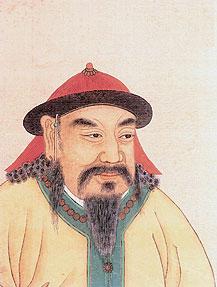
Yesugei Baghatur or Yesükhei was a major chief of the Khamag Mongol confederation and the father of Temüjin, later known as Genghis Khan. He was from the Borjigin family, and his name means "like nine", meaning he had the auspicious qualities of the number nine, a lucky number to the Mongols.
Bodonchar Munkhag was a renowned Mongol Borjigin tribal chieftain and warlord. He was a direct ancestor of Genghis Khan who was the founder of Mongol Empire in 1206, as well as the Mongol Barlas tribe of the Central Asian conqueror Amir Timur who was the founder of Timurid Empire in 1370.
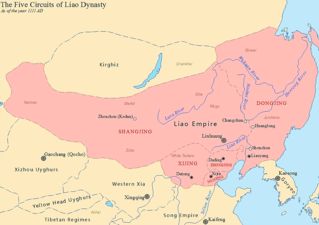
This is a timeline of Mongols prior to the Mongol Empire.
Tumbinai Khan, Tumbinai Setsen Khan, or, Timurids say Tumanay Khan was the Khan of the Borjigin Imperial Mongol tribe, He lived during the 11th and 12th centuries, His son and successor Khabul Khan was the founder of the Khamag Mongol after his death, His second son Khaduli agreed with his brother Khabul Khan, He was the son and successor of Baishinkhur Dogshin who was the son of Kaidu Khan, Tumbinai have 2 Great lineages through his oldest son Khabuls Great-Grandson Genghis Khan who was the founder of Mongol Empire one of the largest Empire in the world which ruled most of Asian Continents and large parts of Europes, and from another son Khaduli Barlas Great-Grandson Qarachar Barlas founder of Barlas Confederation, whos Great-Great-Great-Grandson Timur Barlas who was the conqueror and founder of Timurid Empire in Western Asia, Central Asia and some parts South Asia and East Asia, and through Timurs Great-Great-Great-Grandson Babur who was the founder of Mughal Empire in South Asian Subcontinent.
